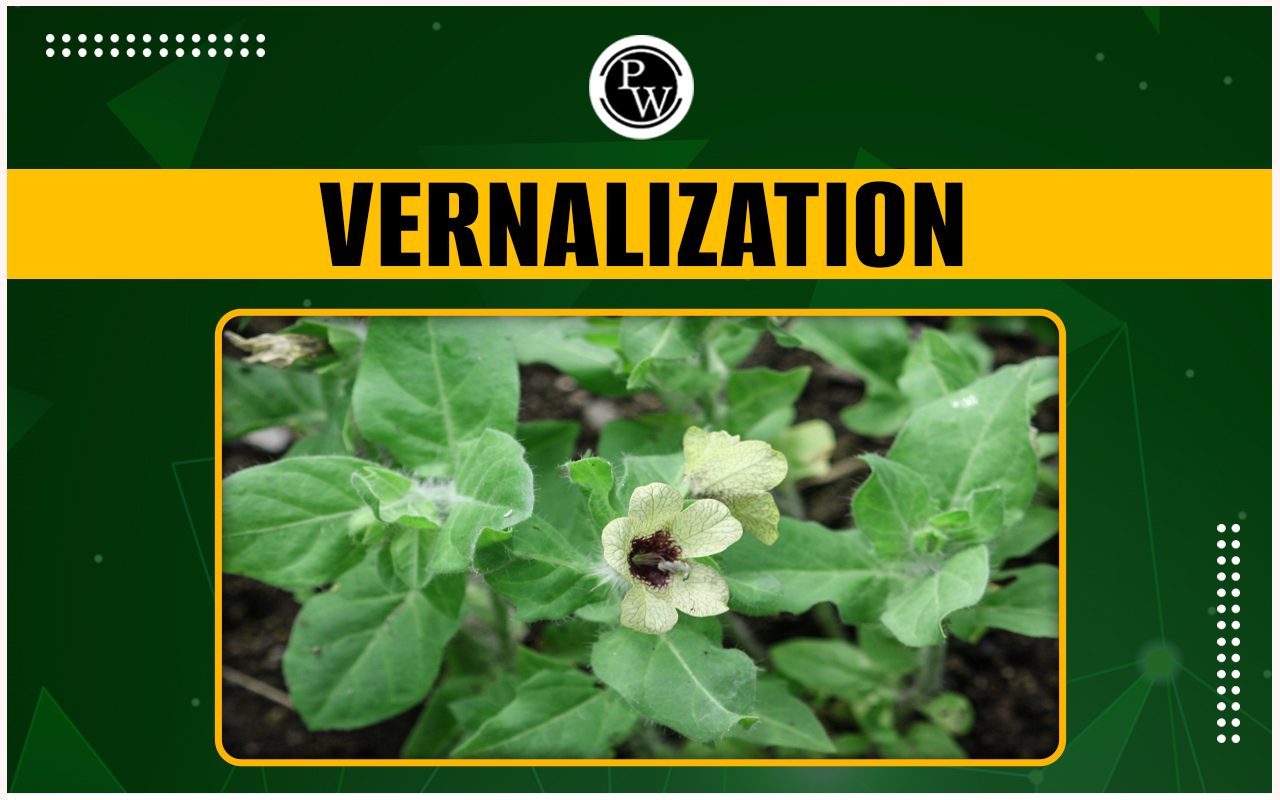

Vernalization: Vernalization is a technique used to enhance the yield of crops by allowing them to grow for a longer period. This is typically done in regions where these crops wouldn't normally grow well. The process of vernalization helps speed up the breeding of plants. For example, wheat plants come in two types: winter and spring varieties. Vernalization also applies to vegetables such as beets, cabbage, turnips, and onions.
In the autumn, the winter variety of wheat is sown. These plants germinate and grow into small seedlings during the winter months, continuing to develop in spring and ultimately being harvested in mid-summer. NEET Biology Notes on Vernalization are provided in the article below.
What is Vernalization in Plants?
In spring, plants bloom and produce seeds. Some flower yearly (annuals), while others flower every two years (biennials). Biennials grow roots and leaves in the first year and flowers in the second, a process called vernalization.
Vernalization in plants refers to the process where a plant requires a prolonged period of cold to trigger flowering. According to this process, biennial plants need exposure to winter between their first year of growth and their flowering stage in the second year to ensure proper germination of flowers. This requirement for a cold period means that biennial plants only produce flowers every other year.
Sexual Reproduction in Flowering Plants
Types of Vernalization
There are two main types of vernalization in plants:
- Obligate vernalization: This type is crucial for a plant to flower. Without exposure to a period of cold temperatures, plants like cabbage, winter wheat, and barley will not flower at all, regardless of day length or other factors.
- Facultative vernalization: This type isn't necessary for flowering but can speed up the process. Plants such as spinach, carrots, and beets will eventually flower even without cold exposure, but flowering will happen later.
The duration of cold needed for vernalization varies among plant species. For example, winter wheat needs a longer cold period than spring wheat. The ideal temperature for vernalization also varies by plant species but typically falls between 0 and 10°C (32 and 50°F).
Mechanism of Vernalization
Vernalization is a natural process that triggers plants to flower after they've been exposed to extended periods of cold weather, typically during winter or similar conditions. The term comes from the Latin word "vernus," meaning "of spring," because it effectively prepares plants for springtime bloom. Once vernalized, plants gain the ability to produce flowers. The process of vernalization involves several steps and theories:
- Phasic Development Theory: This theory suggests that a plant's growth is divided into stages influenced by environmental factors like light and temperature. There are two main phases:
- Thermostage: This phase, which requires cool temperatures, moisture, and aeration, is accelerated by vernalization.
- Photostage: Following the cool phase, this stage needs warmer temperatures. A hormone called vernalin is crucial in triggering the production of florigen, a substance that promotes flowering.
- Hormonal Theories: According to these theories, exposure to cold temperatures stimulates the production of a floral hormone known as vernalin. This hormone moves within the plant and can even induce flowering in non-vernalized plants through diffusion.
The parts of the plant where temperature perception initiates flowering are primarily the active growing points like the shoot tips. Young leaves are particularly sensitive to the vernalization process. The stimulus of cold temperatures is perceived by meristematic cells in areas such as shoot tips, root tips, developing leaves, and embryo tips.
Structural Organisation in Animals
Vernalization Example
Vernalization is a natural process where exposure to prolonged cold temperatures prompts certain plants to start flowering. This is crucial for many plant species, especially those in cooler climates, to successfully reproduce. The following are examples of the Vernalization Process:
1. Wheat ( Triticum aestivum ):
- Requirement: Wheat needs vernalization to begin flowering. Without cold exposure, the plants stay in a non-flowering state.
- Process: In regions with cold winters, wheat seeds are planted in autumn. They experience several weeks of cold (around 0-10°C or 32-50°F).
- Effect: Cold triggers changes in the plant's shoot tips (where flowers form). This prepares them to flower when warmer spring temperatures arrive.
- Outcome: After vernalization, the wheat plants switch from growing leaves to developing flowers, which eventually lead to seed production.
2. Arabidopsis thaliana (Mouse-ear cress):
- Model Plant: Arabidopsis is used to study vernalization due to its short life cycle and well-known genetics.
- Experimental Setup: Researchers can control conditions to study how vernalization works at a molecular level.
- Genetic Regulation: In Arabidopsis, genes like FLC control when flowering happens after cold exposure.
- Research Applications: Insights from Arabidopsis help understand how wheat and barley, among other crops, respond to cold for flowering.
In essence, vernalization is a fascinating biological mechanism showing how plants adapt to environmental changes, ensuring they reproduce effectively in different climates.
Vernalization Temperature
Vernalization is the process that triggers a plant to start flowering after it has been exposed to extended periods of cold temperatures, either naturally during winter or through controlled conditions. Once vernalized, plants acquire the ability to flower, although they may need further signals or time to fully bloom. The temperatures required for effective vernalization typically range from 1 to 10 degrees Celsius (34 to 45 degrees Fahrenheit). Many perennial plants, like fruit trees, rely on this cold period to enter dormancy before they can blossom.
| Important NEET Biology Notes | ||
|---|---|---|
| Selaginella | Embryo | Malvaceae |
| Pinus | Polyembryony | Volvox |
Vernalization Hormones
There is no single hormone that is solely responsible for vernalization. The process likely involves a complex interaction of multiple hormones and signaling molecules.
One potential candidate is a hypothetical hormone known as florigen. It is thought to be produced in leaves when exposed to long days, and then it moves to the shoot tip to initiate flowering. However, the existence of florigen has not been conclusively proven.
Another possibility is that vernalization affects the levels or activity of existing hormones like gibberellins or auxins. These hormones are known to influence flowering, and cold temperatures can influence their balance.
Research into vernalization is ongoing, and scientists are still trying to understand the precise hormonal mechanisms involved.
Factors Affecting Vernalization
Vernalization is a technique used to speed up the flowering of plants by subjecting them to a period of cold temperatures. This process is widely applied to crops such as wheat, barley, and rye, as well as biennial plants like cabbage and sugar beet and perennial plants such as chrysanthemums. Several factors influence how vernalization works:
- Plant Age: The age of the plant affects its response to vernalization.
- Site of Cold Exposure: The parts of the plant where active growth occurs, like the tips of shoots, are where temperature cues are sensed to trigger flowering.
- Suitable Cold Temperatures: Optimal vernalization typically requires temperatures between 0 to 10 degrees Celsius.
- Oxygen Requirement: Oxygen is essential for the plant's metabolic processes during vernalization.
- Duration of Cold Exposure: The length of time the plant spends in cold conditions affects the success of vernalization.
- Water Supply: Adequate water is crucial for the plant's metabolism during vernalization.
These factors can vary depending on the plant species and their specific needs for vernalization. It's important to note that while vernalization benefits certain plants, not all plants require this treatment.
Importance of Vernalization
Vernalization is a process that many plants undergo where they require a period of low temperature to transition from vegetative growth to flowering. This process is crucial for temperate and some tropical plants.
The following are the key reasons why vernalization is important:
- Prevents Premature Flowering: Vernalization ensures that plants do not flower prematurely before reaching full vegetative maturity. This is crucial as it prevents early reproductive development in the autumn.
- Increases Yield and Disease Resistance: Vernalization can enhance plant yield and make them more resistant to fungal diseases. This is especially beneficial for crops like wheat, barley, and rye.
- Facilitates Early Flowering: Vernalization helps shorten the vegetative phase of plants, promoting earlier flowering. This is particularly advantageous for plants with a limited growing season.
- Adapts Plants to Seasonal Changes: Vernalization helps plants adapt to seasonal variations. For instance, winter varieties of some annual food plants, biennials, and perennials experience cold temperatures in winter, which stimulates growth followed by flowering and fruiting.
- Improves Plant Growth: Vernalization allows plants to mature properly and prevents premature flowering during the growing season. It reduces the vegetative phase, accelerating the reproductive period and thereby enhancing overall growth.
In conclusion, vernalization is critical in the life cycle of many plants, influencing their growth, flowering, fruiting patterns, and ultimately their survival and productivity.
Vernalization vs Photoperiodism
Vernalization and photoperiodism are two interesting ways plants control when they flower. These are cues from the environment that affect whether a plant starts making flowers instead of just growing leaves.
Photoperiodism
Photoperiodism is how a plant reacts to how long it's light and dark each day. Plants fall into three types: long-day, short-day, and day-neutral.
- Long-day plants need a certain amount of daylight to start flowering. Examples are spinach, lettuce, and iris.
- Short-day plants only flower when they get less daylight than a certain amount. Examples are chrysanthemums, poinsettias, and rice.
- Day-neutral plants flower regardless of how long the days are. Examples include tomatoes, cucumbers, and beans.
NEET-UG is the most competitive exam for medical and dental college aspirants. Starting early is important. Physics Wallah provides excellent NEET online coaching for Class 12 . Our structured courses and experienced teachers guide students toward exam success. ENROLL NOW!
| NEET Exam Important Links | |
|---|---|
| NEET Syllabus | NEET Biology Diagrams |
| NEET Biology MCQ | NEET Biology Chapter wise Weightage |
| NEET Biology Notes | NEET Previous Year Question papers |
Vernalization FAQs
What is the vernalization process?
What is photoperiodism and vernalization?
What does Vernalise mean?
What are the two types of vernalization?
Why is vernalization important?












